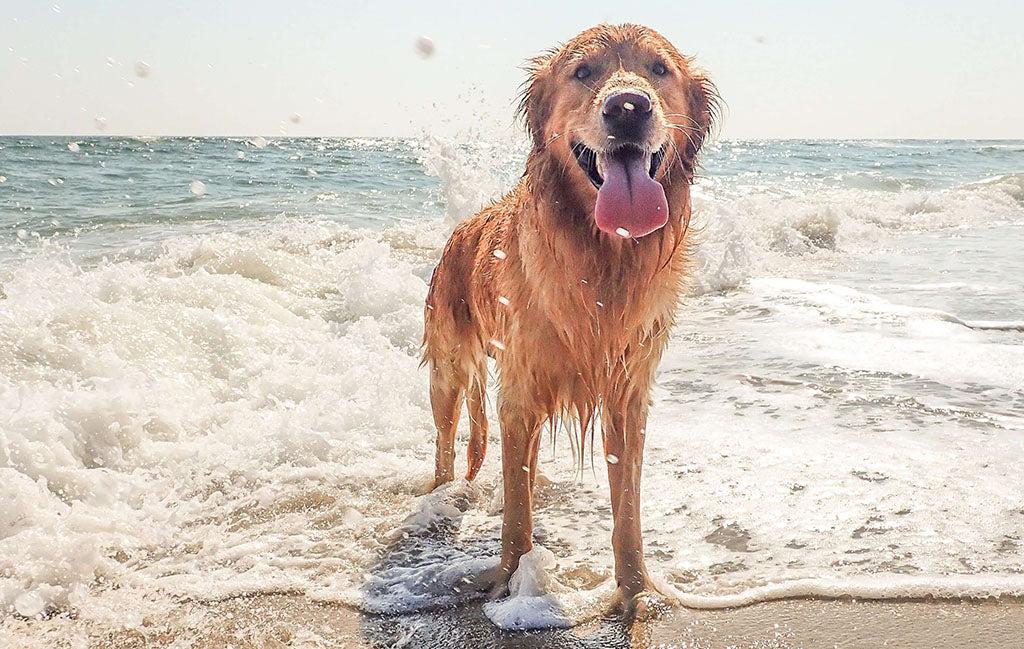Vet Rhiannon Koehler DVM explains how to spot the signs of unhealthy dog poop and provides a helpful unhealthy dog poop chart for pet pawrents to follow.
What Does Unhealthy Dog Poop Look Like? A Vet Explains

Unhealthy Dog Poop: Signs of Unhealthy Stool in Dogs
- Color: Unhealthy dog poop is likely to be an unusual color – not the typical chocolatey brown you’d expect. Unhealthy dog poop could be black, white, orange, green or yellow – if the color isn’t standard, it’s a sign that something might be up.
- Consistency: Unhealthy dog poop may be an unusual consistency – rather than firm, it may be loose, liquid or pebbly and dry.
- Odor: Unhealthy dog poop may have a strong smell – all dog poop smells, but unhealthy stool can have a metallic, fishy or pungent aroma that signals something’s not right.
- Contents: Unhealthy dog poop may contain foreign objects if your dog has been eating something they shouldn’t.
How To Identify Unhealthy Dog Poop
Are you worried that your dog’s poops might be unhealthy? In this helpful article vet Rhiannon Koehler explains what unhealthy dog poop looks like and what you should do if you’re concerned about your dog’s bowel movements.
- Unhealthy dog poop is unlikely to be the usual shade of light to dark brown in color, or the typical log-shape and standard firm-but-not-stiff texture.
- Your dog’s poop isn’t going to smell good, but if the odor is particularly pungent, more so than usual, this could indicate unhealthy poop.
- When you pick unhealthy dog poop up, it may leave crumbles or staining behind.
- Adult dogs generally poop one to three times each day. Puppies will poop more often. If you notice your dog pooping more or less frequently than usual, this may also be an indicator of unhealthy poop.
Unhealthy Dog Poop Chart Infographic

Common Types of Unhealthy Dog Poop
There’s more types of unhealthy dog poop than just diarrhea. You should be paying attention to the consistency, color, contents, and odor, in addition to how frequently your dog is eliminating. Read on to learn more details about the most common signs of unhealthy dog poop.
Unhealthy Dog Poop Consistency
Recall that your dog’s poop should be firm enough to maintain its shape. If your dog’s poop is unhealthy, the consistency may be:
Soft / mushy poop: Soft dog poop or mushy dog poop could indicate that your dog isn’t getting enough fiber, that they have a food intolerance, or are stressed. Some health conditions, such as gastrointestinal parasites, can also cause soft dog stool.
Hard / dry / brittle poop: Hard, dry, or brittle poop usually means the poop either spent too much time in your dog’s gastrointestinal tract or that your dog is dehydrated. Constipation commonly results in hard, dry poop.
Watery poop: Watery dog poop is a nice way of saying dog diarrhea. Runny dog poop can have many causes, including rapid diet changes, stress, gastrointestinal infections, intestinal parasites and more.
Slimy / mucus poop: A small amount of mucus in dog poop can be normal, but mucus poop can indicate that your dog has inflammation of their large intestine (colitis). This can occur due to parasites like giardia, stress, and more.
Grainy or seedy poop: Grainy dog poop could indicate incomplete digestion of food particles or the presence of fecal parasites.
Dog Poop Colors and Meanings
A sudden change in poop color is worth investigating. The following are abnormal poop colors and what they might indicate:
Clear (liquid): A dog pooping clear liquid has diarrhea. Causes of diarrhea can include infections, stress, dietary changes, dietary intolerances, inflammatory bowel disease, and more.
Green poop: Green dog poop may be a sign that the poop is moving too quickly through the intestines, with causes including parasites, bacterial infections, and poor digestion. Poop can also be green if your dog eats grass or something with green dyes.
Yellow poop: Yellow dog poop may be a sign that the poop is moving too quickly through the intestines, with causes including parasites, bacterial infections, and poor digestion. Mucus can also have a yellow color and is usually present due to inflammation in the large intestines (colitis). In some cases, dogs with liver or gallbladder conditions can have a yellow hue to their feces. Again, dyes in the dog’s food can also affect fecal color.
Orange poop: Orange dog poop can occur if food moves through the intestines too quickly, with bacterial or viral infections, and with liver or gallbladder conditions.
Red / Bloody poop: Bright red dog poop or bloody poop often indicates bleeding in the large intestine. Bleeding can occur with colitis, acute hemorrhagic diarrhea syndrome (AHDS), a mass in the large intestine, and more.
White poop: White dog poop is not common. A dog eating too many bones (too much calcium) could have a white hue to their poop. White spots or white specks in dog poop can indicate the presence of parasites like tapeworms.
Black poop: Black dog poop can indicate bleeding in the upper gastrointestinal tract, such as the esophagus, stomach, or small intestine. Stomach ulcers, infections, foreign bodies, and more could result in black dog feces.
Finding Things in Your Dog’s Poop
Generally, your dog’s poop should not have anything identifiable in it. However, your dog’s poop might occasionally have a bit of grass or other items in it. Finding the following items in your dog’s poop might be a cause for concern:
Worms: Worms can be long spaghetti-like noodles or small rice-like white specks.
Pieces of toys / objects: If you see pieces of objects, you should ensure your pet isn’t chewing up items that could cause a blockage.
Undigested food: Undigested food may indicate that the stool is moving through your dog’s bowels too quickly, particularly if the poop is also loose. Some items, such as seeds, could be present because they’re not always digestible for dogs.
Hair / fur: Your dog could have hair or fur in their stools if they’re overgrooming themselves due to a condition like skin allergies, if they’re eating hair out of trash cans, or if they consume wild animals.
Monitoring Your Dog’s Stool Odor and Poop Frequency
A change in the smell of your dog’s feces could indicate a gastrointestinal health issue. A metallic odor to your dog’s poop might indicate the presence of blood, for example. Some bacterial species produce sulfur, so a noticeable smell of sulfur could indicate a bacterial imbalance or infection, particularly if your dog has loose stools.
A fishy odor sometimes indicates that your dog expressed their anal sacs during defecation. If the anal gland smell rarely occurs, it could be normal, but if you’re regularly noticing a fishy odor accompanying your dog’s poop, your dog could have an anal gland infection or allergy that’s affecting their anal sac health.
If your dog is pooping excessively, they will usually have loose stools or diarrhea. Not pooping enough could indicate constipation, especially if your dog is straining to poop with very little coming out.
What to Do If You’re Concerned About Unhealthy Dog Poop
If your dog has one episode of abnormal stools but is otherwise acting normal, you’re usually okay to monitor at home. If your dog’s abnormal poop is accompanied by other symptoms, contact your veterinarian.
Blood in the poop, tarry and black stools, and prolonged episodes of diarrhea may require immediate veterinary attention.
Other signs to watch for include:
- Vomiting
- Loss of appetite
- Excessive drooling
- Straining
- Yelping or attempting to bite when the abdomen is touched
- Hunched posture
- Bloated appearance
- Unproductive retching
- Yellowing of the gums or whites of eyes (jaundice)
- Lethargy
- Excessive panting
- Collapse
If you are concerned at all, contact your veterinarian. For non-emergent visits, you may collect the stool sample for evaluation by your veterinarian.
How to Help Your Dog’s Poop and Digestive Health
Your dog is dependent on you for their dietary needs. This means they’re also dependent on your support for healthy digestion and defecation. The following tips will help you maintain your dog’s digestive health:
- Keep your dog’s diet regular. Frequently introducing new food items and rapidly changing your dog’s diet can lead to gastrointestinal upset.
- Make dietary changes slowly over seven to 10 days. Rapidly changing the diet can cause gastroenteritis, leading to diarrhea.
- Feed high-quality dog food. Your veterinarian is your best source for healthy dog food. Most veterinarians recommend a diet approved by the Association of American Feed Control Officials (AAFCO) for your dog’s life stage. For dogs with health conditions like food allergies, a prescription diet may be recommended.
- Avoid feeding table scraps. Say “no” to those puppy eyes. Table scraps can cause pancreatitis, diarrhea, and other gastrointestinal issues, not to mention an increase in begging behaviors.
- Keep your dog on parasite prevention. The regular parasite preventives recommended by your veterinarian protect your dog from intestinal worms.
- Take stool samples to wellness appointments. Your veterinarian can ensure your dog is free from parasites and that your parasite prevention plan is working.
- Prevent your dog from drinking out of streams or other bodies of water. Drinking water from communal or natural sources can predispose your dog to giardia and other infections.
- Keep foreign objects put away. If your dog is a chewer, remove temptation. Keep chewable items out of reach and use a trash can that latches.
Final Thoughts: Spotting The Signs – Unhealthy Dog Poop
Unhealthy dog poop can clue you in to a wide array of health concerns. Speak with your veterinarian if you are concerned that your dog has abnormal poop after reviewing our chart and remember, consistent monitoring of your dog’s behavior, eating habits and stools will help you pick up on any potential health concerns faster and resolve issues quicker.
 R
R



